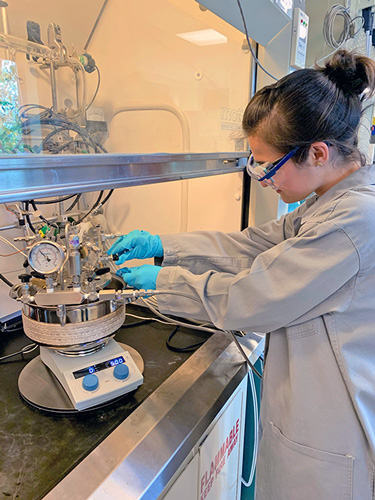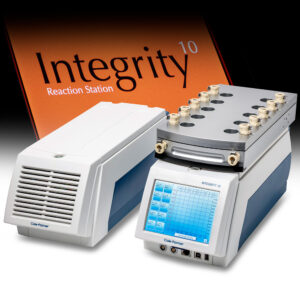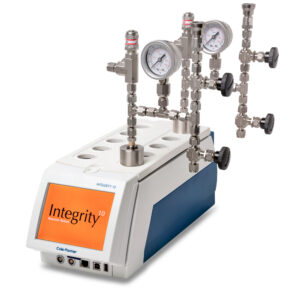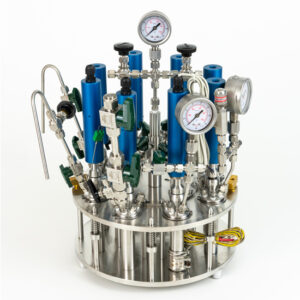Monitoring your reaction process is essential for understanding what’s actually occurring in your reactor. Conventional approaches like off- and at-line monitoring provide important insights into key parameters. Yet both methodologies conduct analysis on samples removed from the reactor. Granted, at-line monitoring is carried out close to the production process. However, neither solution can provide a truly representative look at what’s going in with your reactor contents in real time. Only in-line monitoring using reactor sampling systems can unveil the true process conditions within the reactor – but that doesn’t make in-line monitoring the final word in reactor analysis. All three paradigms have their parts to play.
Off-line, at-line, and in-line monitoring also rely on sampling systems to ensure the efficacy of results. A reactor sampling system allows for samples to be collected from the reactor during a reaction. They enable researchers to optimise outcomes and customise parameters to suit specific application requirements. These systems can be designed for use with various reactor types, including photoreactors and high-pressure reactors. Let’s explore them in more detail.
Collecting Representative Samples
A reactor sampling system’s primary function is to obtain samples that represent the reactor’s contents. Such representative samples are paramount for accurate analysis, ensuring that the data collected mirrors the actual conditions inside the reactor. This accuracy is vital for detecting any deviations from expected conditions, thereby allowing for timely interventions.
Safety First: Remote Sampling in Hazardous Environments
Chemical reactors, by their very nature, can be hazardous. The introduction of a reactor sampling system mitigates risks associated with these environments. By facilitating remote sampling and analysis, these systems significantly reduce the potential exposure of personnel to dangerous substances, ensuring a safer working environment.
Real-Time Data for Immediate Response
One of the standout features of a reactor sampling system is its ability to provide real-time data. This immediacy is crucial for maintaining optimal conditions within the reactor. By offering instantaneous feedback on parameters such as temperature, pressure, and flow rate, these systems enable swift responses to deviations, ensuring the reactor operates at peak efficiency.
Optimising the Reactor Process
Beyond safety and real-time data provision, reactor sampling systems are pivotal in process optimisation. By continuously monitoring key parameters, these systems provide invaluable data that can be utilised to fine-tune the reactor process. Such optimisation ensures that the reactor operates under optimal conditions, maximising both safety and efficiency.
The Advent of Parallel High-Pressure Reactor
The introduction of the Parallel High-Pressure Reactor has further underscored the importance of effective sampling. With the capability to conduct multiple hydrogenation reactions simultaneously, these reactors demand a robust and efficient sampling system. The ability to sample under pressurised conditions, especially during in-reaction sampling, becomes essential. This ensures that the data collected is both accurate and timely, allowing for real-time adjustments to the reactor’s conditions.
 |
Multicell HPR Evaluation relating to published paper: The Key Role of the Latest N-H Group in Milstein’s Catalysts for Ester Hydrogenation |
The Future of Reactor Sampling Systems
As the chemical industry continues to evolve, the role of reactor sampling systems will only become more pronounced. These systems, with their ability to provide real-time data, ensure safety, and optimise processes, are indispensable tools for any modern chemical reactor.
When selecting a reactor sampling system, it’s essential to consider the following features:
- Configuration: Ensure the reactor vessel’s design aligns with the specific application. Bespoke reaction vessels might be necessary for certain applications.
- Temperature Control: The reactor should consistently maintain the desired temperature. Some reactors, compatible with magnetic hotplate stirrers, are apt for temperatures ranging from ambient to +300 ⁰C.
- Inert Atmosphere Control: It’s crucial for the reactor to sustain an inert atmosphere to avert undesired reactions. Certain reactors come with built-in inlet and outlet ports, making them adaptable for various applications, including gas reactions.
- Sample Management: The reactor should facilitate effortless sample addition or removal during the reaction process.
At Asynt, we recognise the significance of these systems, especially in the context of multicell parallel pressure reactors. Our work in this field is a testament to our commitment to advancing the chemical industry, ensuring reactors operate safely and efficiently. We invite you to explore our offerings and join us in shaping the future of chemical reactions. Feel free to explore more details on our work with multicell parallel pressure reactor.
Contact us if you’d like more information about our laboratory pressure reactors – you can talk to us via the LIVE CHAT box at the bottom right corner of your screen, email via [email protected], or telephone +44 (0)1638 781709 for a chat!
Further reading…
 |
 |
| Integrity 10 Reaction Station
Run 10 separate reactions in parallel, setting the temperature and stir rate individually for each cell. These parameters can be precisely controlled, with users able to design specific temperature profiles for each individual experiment, and record all data electronically. |
Asynt offer a unique parallel pressure reactor module system to complement the Integrity 10, manufactured to your exact requirements. Choose from just one pressure module, up to 10, all of which are capable of an independent reaction carried out under pressure conditions. |





